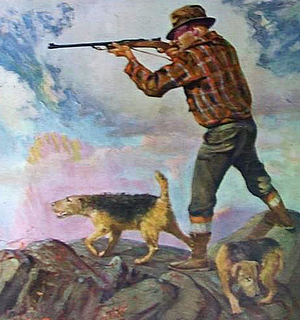
A very few decades ago there was no such dog as the airedale. His various blends of physique and temperament were distributed among several distinct breeds, such as the shaggy otter hound, the wire-haired terrier and one or two others. From each of these breeds, the airedale has taken something worth while- the terrier's alertness and gameness, the otter hound's scent-powers, courage and solid virtues, and so on through the lot.
The most generally accepted version of the airedale's origin is this: Among the mine-pits of the Ayr, the various groups of miners each sought to develop a dog which could outfight and outhunt and outthink the other mine's dogs. Tests of the first-named virtue were made in inter-mine dogfights. Bit by bit, thus, an active, strong, heroic, compactly graceful and clever dog was evolved- the earliest true form of airedale.
Then the outer world's dog fancy got hold of him and shaped and improved him into the show-type airedale terrier of today. The process was not long, for the newly evolved dogs were quick to adapt themselves to their creators' wishes. Out of the experiments emerged the modern airedale, a dog that does not know the word "fear." He is swift, formidable, graceful, big of brain, an ideal chum and guard.
There is nothing he is afraid to tackle. There is almost nothing he cannot be taught if his trainer has the slightest gift for teaching. To his master he is an adoring pal. To marauders he is a destructive lightning bolt.
In the southwest and elsewhere, the otter hound ancestry and its traits have been made use of by numerous sportsmen in teaching airedales to do the work of pointers and setters and other hunting dogs. For nose and for steadiness and for snappy retrieving and for finding fallen birds, these field-trained airedales have given surprisingly good account of themselves.
There is nothing thrown away in an airedale's make-up. Every inch of him is in use. Compact, wiry, he is "all there." No flabby by-products. A perfect machine- a machine with brain, plus.
Crossbreeding is apt to have a stimulating effect on the mind and the physique of all dogs. The airedale is still so new, as a distinct breed, that he retains an unusual amount of the sense and the strength of the primal cross-breed, an asset of high value in this era of delicate and inbred dogs of so many kinds.
At almost the outset, the airedale's long tail was sacrificed to trimness and to fighting efficiency. Don't get the idea he is born with the smartly stumpy tail he now sports. It is amputated, at precisely the right length, while his a baby. He is born long-tailed, just as the bull-terrier and the Great Dane and the Doberman are born with lop ears, and later have their ears cut, painfully, to the shape and pricked position demanded by fashion.
Centuries ago, so it is said, a tax was imposed on all dogs' tails- presumably inferring a tax on the whole dog. Rich men paid the tax in order to keep their dogs. Poor men loved their mongrel dogs as much as the rich loved their thoroughbreds. But they could not afford to pay the high tax. So they hit on the idea of cutting off their dogs' tails, so that there should be no tail to be taxed. The animals thus docked were know as "curtailed dogs," shortened presently to "cur dogs" or to "curs."
The airedale's tail was cut off for no such cause as this, but to add to his trimness and to be out of the way in a fight. It adds a finish and style to his looks, this semi- erect tail stump.
For a long time there was a belief among many that airedales' tempers were as short as their tails. This is not true. The airedale will not avoid a fight. But he seldom goes looking for one. As a rule he is courteous to his master's accredited guests and to the world at large. He minds his own business and does what his owner tells him to. Incidentally, he shows powers of brain and of instinct found in few other dogs. He can be humanized to a remarkable extent.
Yes, the airedale is worthy of the words of the late Senator Vest, of Missouri.
Fashion can never rule him out of existence. Too many people have learned to value him above any other breed. He is here to stay. He has won his right to permanence.
No comments:
New comments are not allowed.